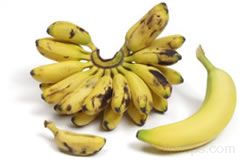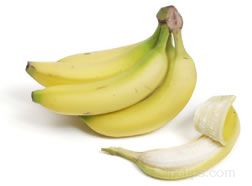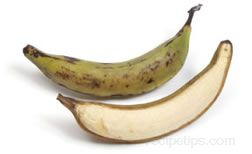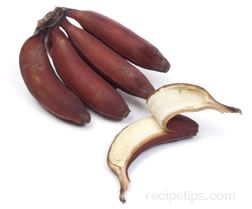| Bananas |
|

Native to tropical regions, a banana has a tough outer peel that may be yellow, red, green, or black when ripe. All varieties have a sweet fragrance when ripe and contain a soft creamy flesh inside that may be white, yellow or pinkish cream colored. There are hundreds of different varieties of bananas but there are several varieties more commonly available. The Cavendish banana is the most common. Other varieties include Baby (also known as Lady Finger or Nino), Blue Java ( also known as Ice Cream) Burro, Hua Moa (also known as Hawaiian), Manzano (also known as Apple), Plantain, and the Red banana (also known as the Jamaican). This fruit is often harvested in a green, unripe stage, but will continue to ripen and turn yellow, red, brown and black when kept at room temperature. Bananas are more flavorful when allowed to ripen off the plant. When bananas are refrigerated, the skin darkens quicker, but they are kept from becoming soft and mushy for a longer period of time. |
|
Uses:
Bananas are most commonly eaten fresh out-of-hand but can be used for many purposes. They can be added to desserts, such as pies, cakes, bars, muffins, and breads. Bananas also go very well when mixed with yogurt, ice cream, puddings, and custards. They are added to fruit salads, adding a sweet flavor and smooth texture to compliment the other fruit. Bananas can also be cooked by baking, frying, boiling, steaming, and sautéing. They are used in savory dishes to add a sweet flavor and chewy texture. Bananas can be dried and eaten as a snack. Drying increases their sweetness and produces a nutritious but high calorie snack.
Plantains, a bland and starchier variety, are most often cooked and eaten as a vegetable. They are a popular ingredient in many African and West Indian dishes. They are generally boiled, baked, fried, broiled, microwaved or mashed, and they are rarely eaten raw as a fruit unless they have ripened to a point where the skins are completely black. |
|
At Their Best:
Available year-round. |
|
How to Buy:
The stage of ripeness that you buy bananas at will depend on personal preference and desired use. All green bananas are unripe and should not be eaten. Bananas that are mostly yellow with just a tinge of green at the ends will have a crisp texture and fresh taste. All yellow bananas that have a few small brown or black specks are fully ripe and will have a sweet taste and smooth texture. As more specks develop the banana becomes overripe and although the flesh continues to sweeten, it also begins to soften. Once the skin is all browned, it is over ripe and should not be eaten but can be mashed and used for cooking.
If you are buying bananas to eat out-of-hand, buy them at the stage that you prefer the taste and texture. When purchasing to mix with other fruits to make a salad, buy bananas that are fully ripe. Do not purchase overripe bananas unless you intend on using them for cooking.
Plantains should be purchased when green or yellow with black spots if being used for cooking. Do not purchase completely blackened plantains unless you intend to eat them as fresh fruit.
Follow these guidelines if buying bananas for immediate use but if you have time for the bananas to ripen to the stage that you desire, you can buy them when they are still green or under ripe and they will ripen at home when stored at room temperature. Avoid purchasing bananas that have soft spots or damaged skins. |
| Storage:
Store at room temperature. Do not expose the fruit to extreme temperatures. Unripe bananas should not be stored in the refrigerator because the cold temperature will stop the ripening process. Ripe bananas can be stored in the refrigerator for a few days to extend their usage time before they become too ripe. Once they are placed in the refrigerator their peel will turn brown but this will not affect the flesh of the banana. If stored with other fruit, bananas will accelerate the ripening of the other fruit.
Ripe bananas can be mashed and then frozen. When mashing, add a little lemon juice to prevent the fruit from discoloring. The mashed bananas can be placed in air tight freezer bag and stored in the freezer for up to two months. You can use the frozen bananas in recipes such as salads and fruit shakes or they can be thawed and used in breads, cakes and muffins. |
| Varieties: |
|
Baby Banana
 |
A smaller variety of the larger Cavendish cousin, shown at the right. The baby banana is very sweet in flavor and unique in its smaller appearance, generally no more than 3 inches long. It is a variety that is often used in fruit salads, for baking breads, or as a snack. The baby banana is grown in the tropical countries of South America, the Caribbean, Asia, and Africa. When ripe, the skin will be bright yellow and have a cream-colored flesh. Also known as a Finger, a Ladyfinger, a Lady Finger, or a Nino banana. |
|
Blue Java Banana
|
A small plump variety of banana that is commonly used as a dessert or snacking banana. It has bluish-green skin that covers a sweet tasting creamy flesh. This banana is also known as the Blue Java Ice Cream banana. |
|
Burro Banana
|
A flatter, smaller and more rectangular shaped banana, this banana is shorter and chunkier than its cousin, the Cavendish banana. The cream colored flesh provides a distinct lemon flavor when ripe. This banana is used for snacks, in breads, salads, and can be dried for banana chips. |
|
Cavendish Banana

|
The most common variety of banana used in baking, fruit salads, fruit compotes, and to complement foods. It ranges from approximately 6 to 10 inches in length. The outer skin is partially green when sold in food markets and turns yellow when it ripens. When overripe, the skin will turn black and the flesh becomes mushy. Bananas ripen naturally and are at their peak ripeness when the peel is all yellow with a few dark brown specks beginning to appear. |
| Manzano Banana |
A smaller member of the banana family, but not as small as the Baby banana, this variety is sweeter, perhaps somewhat drier, and provides a distinctive strawberry or apple flavor. It has a chunkier or thicker appearance than the traditional banana, with an outside skin that has a pale-gold color. This banana is best eaten when the skin begins to show a greater amount of black color or completely blackens. The Manzano banana is grown in South America, Mexico, Caribbean, Asia, and Africa and is also known as the Apple banana. |
|
Plantain Banana

|
A large "cooking banana" that is flatter and longer than the common Cavendish banana. With a firm texture and a mild flavor, similar to a squash, the flesh of this banana contains less sugar but more starch than other varieties. Consequently, it is often served as a vegetable or potato and made into savory dishes. The plantain is frequently used in Mexican and Caribbean cooking and is generally fried, braised, mashed, sautéed, or stewed. The thick skin of the plantain ranges in color from green prior to ripening to yellow and then brownish-black as it fully ripens. Its flesh is light pink or light salmon in color and darkens as it ripens. As it ripens the starch turns to sugar, making it sweet enough to use in desserts. |
|
Red Banana

|
A variety of banana, with a reddish-purple skin, that is shorter and plumper than the traditional Cavendish banana. Raw red bananas have a flesh that is cream to light pink in color and are sweeter than the yellow Cavendish varieties. The red banana is at its peak ripeness when some black spots have begun to appear on the reddish-purple skin. When ripe, their texture is somewhat soft, making them less of a good quality eating banana. Grown in South America and Asia, this fruit can be used in salads or fruit compotes, but is most often used as a baking banana. Red bananas are also known as Jamaican bananas. | |



